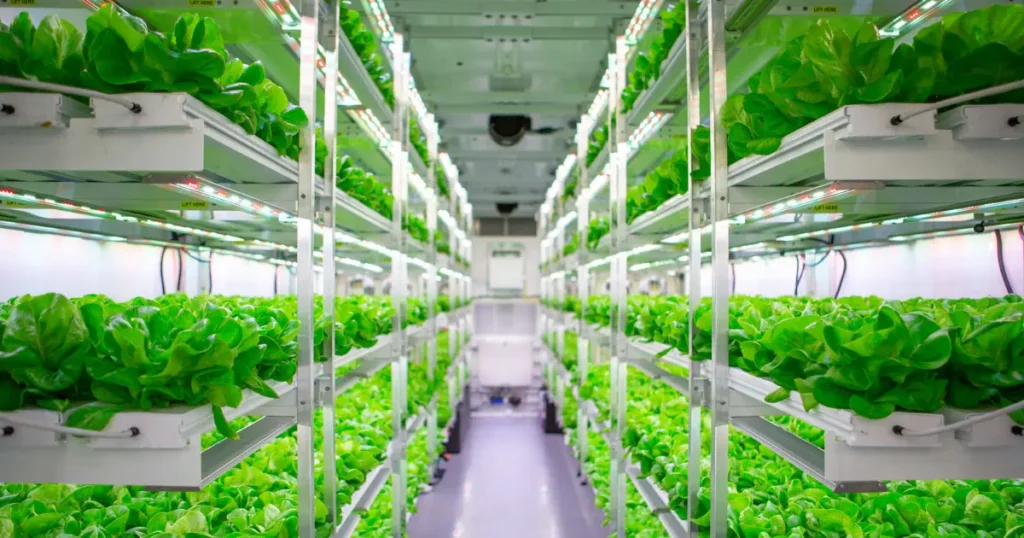Vertical Farming: The Ultimate Key to Hydroponic Agriculture
Table of Contents
ToggleIntroduction
In the face of increasing global food demand and dwindling arable land, innovative agricultural methods are necessary to ensure food security. One such revolutionary technique is vertical farming, which integrates seamlessly with hydroponic agriculture to maximize efficiency, reduce resource consumption, and enhance crop yields. Vertical farming is redefining modern agriculture by leveraging cutting-edge technology, controlled environments, and space optimization. This article delves into the transformative role of vertical farming in hydroponic agriculture and why it is a game-changer for the future of food production.
What is Vertical Farming?
Vertical farming is an advanced agricultural technique that involves growing crops in vertically stacked layers, often within controlled indoor environments. Unlike traditional farming, which relies on vast horizontal land areas, vertical farming optimizes space by utilizing shelves, towers, or containers. It is often combined with hydroponic agriculture, where plants grow without soil, instead receiving nutrients through nutrient-rich water solutions. This combination results in a sustainable, high-yield, and resource-efficient farming system.
The Role of Vertical Farming in Hydroponic Agriculture
Maximizing Space Efficiency
.
One of the most significant advantages of vertical farming in hydroponic agriculture is space utilization. With urbanization reducing available farmland, vertical farming enables food production in urban areas, abandoned warehouses, and even shipping containers. By growing plants in stacked layers, farmers can produce significantly more food per square foot compared to traditional methods.
Resource Conservation and Sustainability
.
Vertical farming combined with hydroponics uses up to 90% less water than traditional farming. Since hydroponic systems recycle nutrient solutions, water wastage is minimized. Additionally, vertical farms use controlled lighting and climate systems to optimize plant growth, reducing dependency on natural weather conditions and decreasing the need for chemical pesticides.
Year-Round Crop Production
.
Traditional agriculture is heavily influenced by seasonal changes, but vertical farming in hydroponic agriculture operates in a controlled environment. This means farmers can grow crops 365 days a year, ensuring consistent supply and reducing the impact of climate change on food production.
Reduced Dependence on Soil
.
Hydroponic vertical farming eliminates the need for fertile soil, making it an ideal solution for regions with poor soil conditions or limited arable land. This technology allows food production even in desert regions or urban environments where conventional farming is impractical.
Improved Crop Quality and Yield
.
With precise control over nutrients, light, and temperature, vertical farming enhances crop quality and yield. Plants receive the exact nutrients they need, leading to faster growth, higher yields, and superior nutritional value. Additionally, since the environment is controlled, there is minimal risk of contamination, ensuring safer and healthier produce.
Reduced Carbon Footprint
.
Since vertical farms are often located in urban areas near consumers, they significantly cut down on transportation costs and emissions associated with food distribution. Vertical farming also reduces the need for deforestation and land conversion, preserving ecosystems and reducing agricultural carbon footprints.
Challenges in Vertical Farming and Hydroponic Agriculture
High Initial Investment
.
Setting up a vertical farm requires substantial capital for infrastructure, automation, and energy costs.
Energy Consumption
.
Indoor farming relies on artificial lighting and climate control, leading to high electricity consumption.
Technical Expertise
.
Managing hydroponic systems and vertical farming structures requires specialized knowledge and skills.
However, advancements in renewable energy, automation, and artificial intelligence are steadily overcoming these challenges, making vertical-farming more feasible and accessible.
Future of Vertical Farming in Hydroponic Agriculture
The future of vertical farming looks promising as technology continues to evolve. Innovations such as AI-powered monitoring systems, automated harvesting, and energy-efficient LED lighting are making it more sustainable and cost-effective. Governments and private enterprises worldwide are investing in urban vertical farms to enhance food security and reduce the environmental impact of traditional farming.
As consumer demand for fresh, local, and pesticide-free food grows, vertical farming in hydroponic agriculture will play a crucial role in meeting these expectations. By integrating smart technology, renewable energy sources, and data-driven farming techniques, the next generation of vertical farming will further revolutionize agriculture.
-
Bacteria: The Remarkable Role of Microbes for Growing Plants in Hydroponics
-
Hydroponics: The Rookie Mistakes of Growing Plants
-
Chlorine: The Incredible Key to Thriving Hydroponic Plants
-
Molybdenum: Astonishing Importance for Hydroponic Plant Growth
-
Boron: The Astonishing Importance for Plants Growing in Hydroponics
-
Copper: A Powerful Element for Hydroponic Plant Growth
-
Zinc: The Powerful Secret to Hydroponic Plant Growth
-
Manganese: Essential role for Hydroponic Plant Growth
-
Iron: The Crucial Role of Iron in Hydroponic Plant Growth
-
Sulfur: The Vital Key to Thriving Hydroponic Plant Growth
-
Magnesium: The Crucial Role for Thriving Hydroponic Plants
-
Calcium: The Critical Importance for Thriving Hydroponic Plants
Conclusion
Vertical farming, when integrated with hydroponic agriculture, represents a transformative shift in modern food production. By maximizing space efficiency, conserving resources, and enabling year-round crop cultivation, this innovative method offers a sustainable solution to the challenges of traditional farming. Although high initial costs and energy consumption remain obstacles, continuous advancements in technology are making vertical farming more viable and accessible. As global food demand rises and environmental concerns intensify, vertical farming will play a crucial role in ensuring food security, reducing carbon footprints, and promoting a more resilient agricultural future. Embracing this cutting-edge approach will not only revolutionize the way we grow food but also contribute to a more sustainable and food-secure world.

